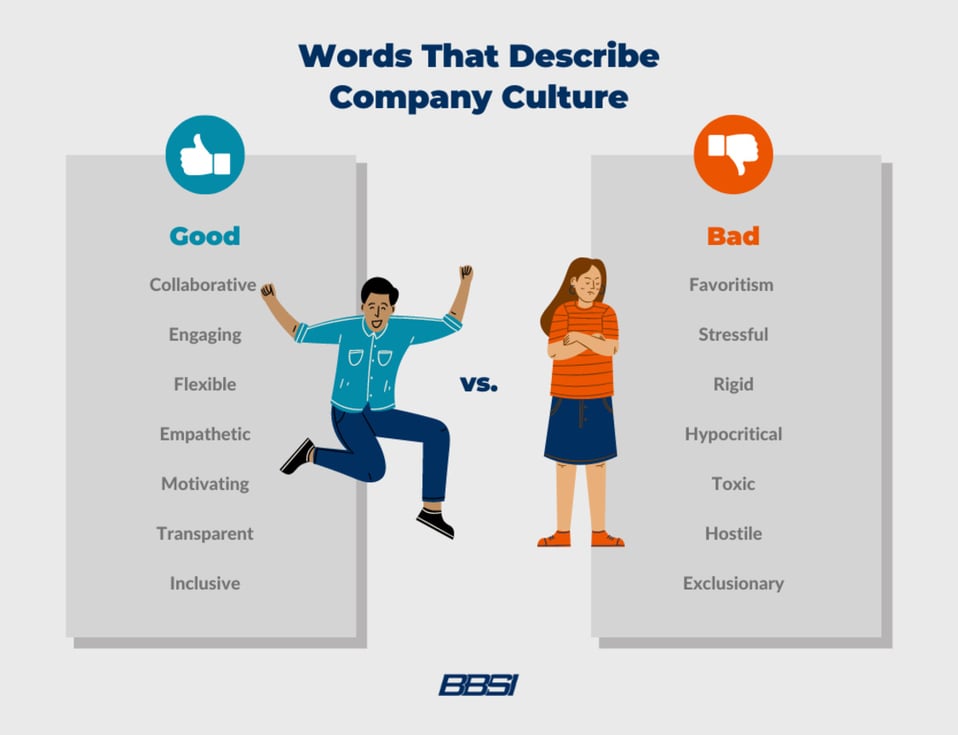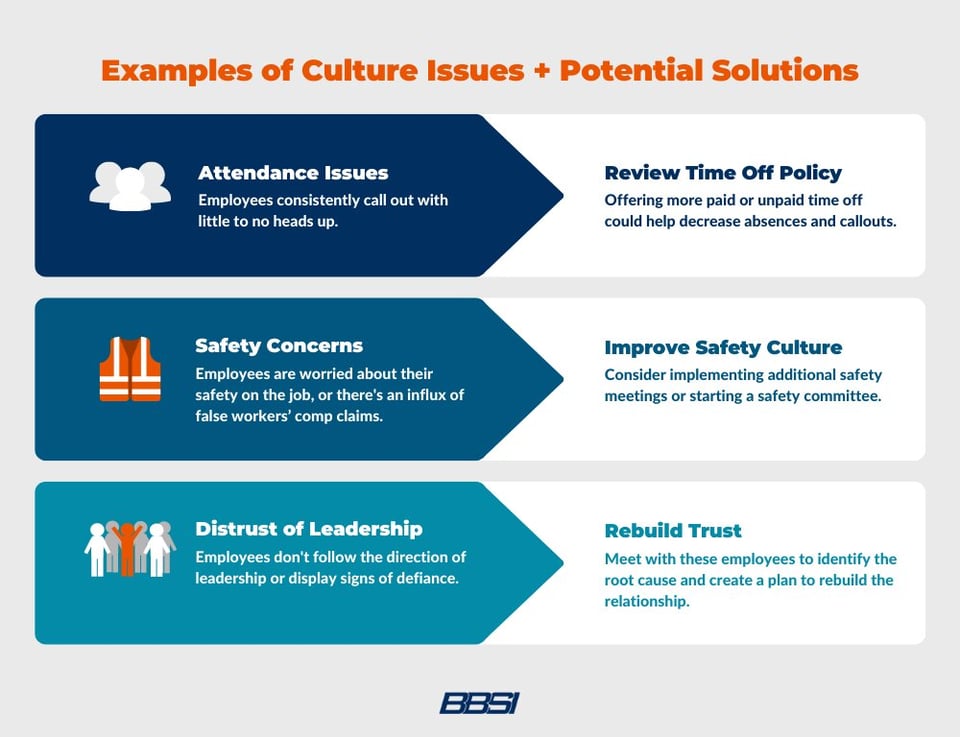
Tame the Toxic: How to Create a Company Culture Employees Actually Want
Expertise provided by Amanda Mumford, BBSI HR Consultant
Competition among employers to hire and keep the best talent is still fierce. In the wake of the global workplace shake-up incited by the pandemic, many employers struggle to maintain a working environment that builds and preserves employee loyalty.
Workers leaving their employers mention many reasons for the change. According to a Pew Research study, 57% of employees leaving their jobs last year mentioned feeling disrespected, with 35% citing it as one of the main reasons for their resignation.
Gone are the days when employees would tolerate the occasional slight to keep the peace at work. And why should they? Full-time employees spend an estimated 90,000 hours at work throughout their lifetime. With prospective employees prioritizing healthy company culture over other factors, it's time for employers to embrace the idea of putting culture first.
TABLE OF CONTENTS
What is Company Culture?
The term "company culture" can mean different things to different people. Yet, it creates the overall experience felt by every employee every day.
Harvard Business Review defines company culture as the social order of an organization. Company culture expresses an organization’s values and beliefs through shared assumptions and group norms within the workplace. These group norms define what is accepted, rejected, encouraged, and discouraged. It conveys an organization's values, beliefs, and goals through words and actions.
Company culture includes several elements of a business:
- The work environment
- The mission statement and core values
- The company’s management style
- General workplace ethics
A company's culture can be created deliberately and developed naturally. How much a company focuses on its culture determines whether it'll be able to mold it intentionally or grow it on its own.
Factors That Shape Company Culture
Mission Statement: Employees and employers should be on the same page when it comes to understanding company goals. Clearly defining the business mission paves the way for good company culture. Employees with a clearly defined purpose will adapt their day-to-day actions to support the company's shared goals and drive effective results.
Values and Ethics: A company defines its values and ethics through its daily actions. Establishing beliefs early on will positively impact a company's governing behavior across its operations. The behavior employees observe in company leadership will be the behavior they model, defining daily life for the business from top to bottom.
Work Environment: An employee's surroundings deeply affect their work performance. This is evident in the rise of more fluid work practices, like flexible work hours or a work-from-home option. Companies welcoming these trends create a more adaptive workspace for employees, and creating an environment where employees are comfortable at work has increased productivity.
Employee Interactions: The evidence of good company culture is most prominent in the interaction between team members. Companies with a perpetual, open flow of ideas know how to talk about good company culture because they have open communication and shared goals. But if employees tend to ignore one another and engage in unnecessary competition, a company should take a closer look at the environment they've created.
Leadership: Because leaders are models of behavior for their teams, their actions can significantly influence a company’s culture. Managers and supervisors exemplifying traits like honesty, fairness, and respect have a trickle-down effect, positively impacting the behavior of the employees they lead and the work environment overall.
Disciplinary Measures: Companies are defined by what they will not tolerate as much as they are defined by what they promote. Toxicity is contagious, and how a company responds sends a clear message to employees about what is and isn’t acceptable. For example, companies that publicize intolerance of discrimination and bullying, but do nothing when it appears in their workplace, are not exhibiting an alignment with the company culture they are attempting to promote.
Benefits: To employees, benefits are a measurement tool for how much a company values its people. A company that claims to value its employees can show the sincerity of its words through competitive benefit offerings, which creates a positive company culture by breeding company loyalty.
Why Should Companies Understand and Define Their Company Culture?
When most people think of a company's brand, they think of its primary slogan or logo design. But good company culture is part of branding too. A company's employees are the frontline ambassadors who tell the world whether it's a healthy or flawed company.
Take Gravity Payments, for example. Since CEO Dan Price committed to paying employees a base salary of $70,000 per year, the company has exploded. With a wave of good PR, the company has doubled the number of its employees, and the value of the payments it processes has increased from $3.8 billion a year to $10.8 billion a year.
With a commitment to creating a good company culture, Dan Price branded Gravity Payments as a leader in employee wellbeing, and the talent and business followed.
However, it’s not just the CEO who defines how culture brands a company. When hiring supervisors and employees, considering whether or not a candidate fits into the current company culture is essential. Ignoring this could change a company's culture negatively and shift its brand perception. This shift will likely result in higher employee turnover and decisions that stray away from what a company wants its culture to be.
It's up to a company to define itself. Executives, supervisors, and employees alike will follow the north star that a company points toward. A company without a north star will find itself lost in a sea of mediocrity.
The Benefits of a Good Company Culture
It's not just employees who benefit from good company culture. Leadership will also profit from the consistent productivity and customer satisfaction that result from it.
Higher Employee Retention and Engagement: When employees find a company with a culture they like and feel comfortable in, they stay. Employees who genuinely feel cared for are less likely to leave a company because they know it will be difficult to find that personal connection elsewhere.
Attract Better Talent: The best employees are attracted to companies that have a good company culture. Additionally, new employees who are a good culture fit contribute to the environment, increasing a company's value to prospective talent.

Increased Productivity: According to Oxford, happy workers are more productive — in fact, 13% more productive than others. Good company culture creates a more engaged workforce, and companies that are dedicated to nurturing their workers also cultivate a more productive business.
Better Customer Sentiment: Now more than ever, customers are concerned with how businesses treat employees. Companies that take care of their workforce tend to have a better reputation among consumers.
Helps Companies Avoid False Workers’ Compensation Claims: While most claims are legitimate, studies show that one to two percent of workers’ compensation claims are false. Creating a culture that keeps employees happy and engaged helps companies avoid fraudulent claims. If employees don't have reason to feel the need for retribution, claims tend to be lower, saving the company valuable time and money.
5 Steps for Improving Your Company Culture
1. Identify the Systemic Problems
The first step in solving a problem is admitting that there is one. Companies that see high turnover and have difficulty retaining employees should take a step back to look at themselves objectively to see where the problems exist before claiming "it's the market." It's not that employees don't want to work; plenty of companies aren't experiencing staffing issues during the Great Resignation. These companies have created a company culture that employees want to work in and thrive in difficult times.
A company can get an idea of its current culture by listening to how its employees describe or talk about it. Here are some common words used to describe company culture that offer insight into how employees feel:

Words That Describe Good Company Culture
- Collaborative: Employees work as a cross-functional team to accomplish common goals.
- Engaging: Employees are invested in and inspired by their work.
- Flexible: Companies and employees adapt to the needs of one another to help reach their goals.
- Empathetic: Team members understand others' points of view and forge personal connections.
- Motivating: A company appreciates employees' accomplishments and encourages taking on new challenges.
- Transparent: Even in difficult times, honesty builds trust and confidence in a company's staff.
- Inclusive: Everyone, regardless of background, gender, race, or personal identity, feels represented.
Words That Describe Bad Company Culture
- Favoritism: A company that displays preferential treatment loses trust and breeds resentment.
- Stressful: Stress and a poor work-life balance lead to burnout and loss of productivity.
- Authoritarian: Employees who feel like they're being dictated to rather than included are less likely to offer ideas and support.
- Hypocritical: Witnessing a company contradict its values and stated goals creates distrust and resentment.
- Exclusionary: When an employee feels distinctively devalued and ignored due to their unique qualities.
- Toxic: A working environment that feels negative, hyperbolic, and disruptive to both work and life.
- Hostile: An overly competitive and aggressive environment can erode employees' mental health.
- Rigid: Highly restrictive rules and complex hierarchies of the past drive away talent.
2. Find the Root Causes of Systemic Issues
Once a company accepts there is a problem, it's time to pinpoint the cause. Which department has a high turnover? What do employees like and dislike about working there? Companies should find a safe and anonymous way to connect with their employees to find out what does and doesn't work for them.
If a company’s employees won’t answer critical questions directly because they fear it will threaten their employment, the company should consider hiring third-party interviewers to facilitate those anonymous conversations. Getting to the truth — no matter what it is — is crucial.

3. Create a Plan of Action
Once a company has pinpointed the problems in its company culture, it's time to address them. The responses to these potential problems are as diverse as the problems themselves. Some examples of problems and potential solutions are:

Attendance Issues: If employees call out often, it could be because a company doesn't offer enough paid time off. Offering better benefits could help decrease the number of absences an employer experiences.
Safety Concerns: If employees are concerned with their safety while on the job, or a company sees an influx of false workers’ comp claims, an employer could consider implementing additional safety meetings or starting a safety committee.
Lack of Trust in Leadership: If employees don’t follow their supervisors, they probably don’t trust their leadership. In this case, companies should meet with these employees to get to the root of the problem. From there, a company can devise a plan for rebuilding the bond between its leadership and employees.
It's not until a company gets to the root cause of a problem that it can discover the best way to address it.
4. Prioritize Your Initiatives
A company facing culture problems may ask, "How long does it take to change a company culture?"
The answer: As long as it takes.
There's no set time for making a monumental shift in company culture, and companies who try to achieve this feat in as little time as possible usually find themselves failing.
Changing a company culture means changing hearts and minds, which takes time. The best thing a company can do is prioritize the issues that will make its people more content and more productive. From there, take the time to address each initiative one at a time so issues get resolved in a sustainable way.
5. Get Company Buy-in
A company's loudest employees are its biggest brand makers for company culture. Once a company can get these employees to buy into culture shifts, they will help rally the rest of the team. Here are a few requirements for employee buy-in:
- The change has to be tangible. Employees need something they can see and feel to buy in. If they share feedback about being physically uncomfortable at work, buying new ergonomic furniture shows employees the company is listening.
- The change has to be impactful. Suppose employees have issues with the lack of recognition for surpassing goals. In that case, a company should reward them for their extra effort in monetary or social recognition.
- The change has to tap into what makes employees tick. Employees aren’t motivated by money alone. In fact, much of the Millennial generation values experiences. Tapping into what motivates the workforce will help companies rally their employees behind the changes.
Tips for Maintaining A Healthy Company Culture
Practice What You Preach
People are tired of seeing their leadership live by different rules than what they enforce. The best thing a company can do, especially its leadership, is live by the values and culture code they set forth for the entire company.
Create Policies and Procedures That Reflect Your Values
Values and ethics will lead a company to its ideal destination. A company's policies are the routes it takes to get there. A company should recognize its deeply held values and create policies that reflect them.
Recognize Employee Performance
When a baseball player hits a home run, the whole team greets the player at home plate. This is precisely how recognition should be done in business.

Employees value recognition, and rewards can be a huge recognition driver. However, it doesn’t always have to be monetary. If a team puts in a lot of work to achieve a goal, consider providing lunch or letting them off early for a long weekend. This type of recognition makes employees feel valued, generates a closeness between leadership and employees, and urges them to continue their hard work.
Refresh Training and Onboarding Procedures
Culture and values aren't just things to talk about during the interview process; they're a way of life within a company. When onboarding a new employee, it's imperative that the processes and procedures reflect this culture and set clear expectations from the beginning.
Recruit and Hire Carefully
It's harder to teach attitude than skill. It is okay to require certain skill sets during the recruiting process, but hiring prospective talent based on cultural fit can avoid new hires shaking up the culture in a bad way. Try hiring for attitude and training for skill.
Gather Employee Feedback and Establish Open Communication
A company is not a machine; it's as alive as the team members who inhabit it. Therefore, it's critical to get feedback from employees constantly. Leadership should take time to work alongside their teams and understand their daily experiences because no one knows the company culture as they do.
How BBSI Helps Companies Improve Company Culture
The journey to a healthy company culture starts with discovery, and that's what BBSI is here to help you do.
Changing your company's culture may seem like a daunting process you may not have time to tackle. When you partner with BBSI, you’re partnered with a dedicated team of professionals who can help you pinpoint problems in your company's culture, create tailored solutions to initiate change and help you take the necessary steps to define your values and supporting procedures.
Contact your local branch today to see how we can help you create a culture where employees and leadership thrive together.
Disclaimer: The contents of this white-paper/blog have been prepared for educational and information purposes only. Reference to any specific product, service, or company does not constitute or imply its endorsement, recommendation, or favoring by BBSI. This white-paper/blog may include links to external websites which are owned and operated by third parties with no affiliation to BBSI. BBSI does not endorse the content or operators of any linked websites, and does not guarantee the accuracy of information on external websites, nor is it responsible for reliance on such information. The content of this white-paper/blog does not provide legal advice or legal opinions on any specific matters. Transmission of this information is not intended to create, and receipt does not constitute, a lawyer-client relationship between BBSI, the author(s), or the publishers and you. You should not act or refrain from acting on any legal matter based on the content without seeking professional counsel.
